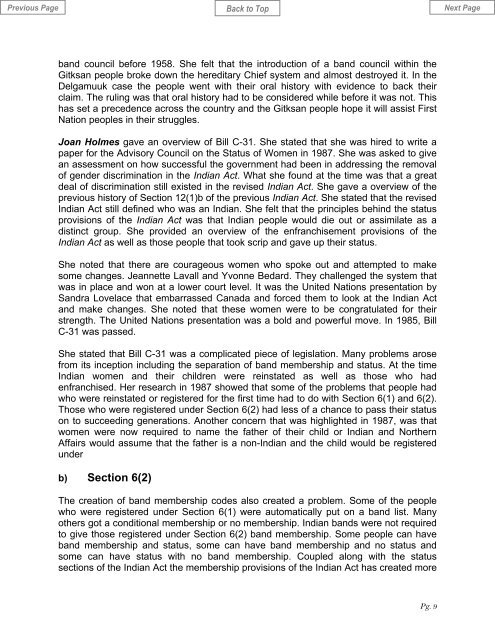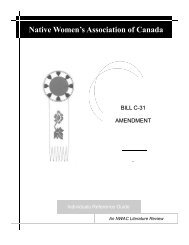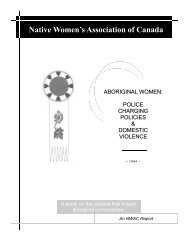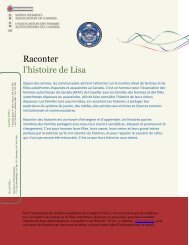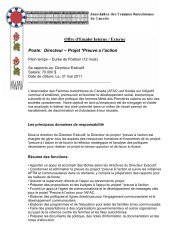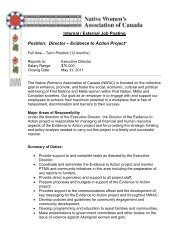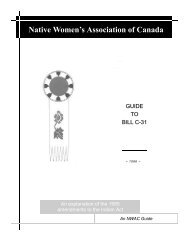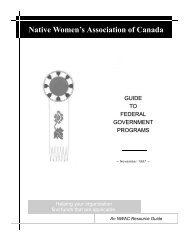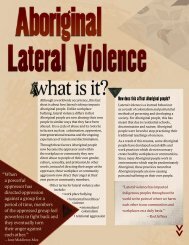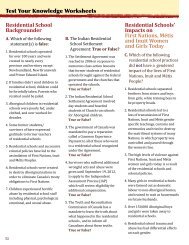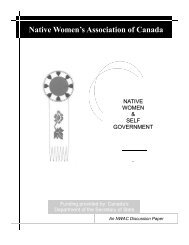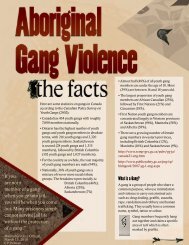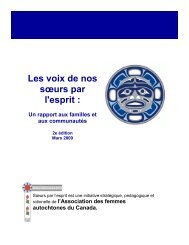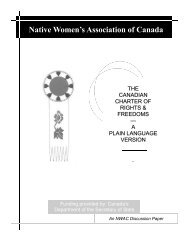BILL C-31 - Native Women's Association of Canada Website
BILL C-31 - Native Women's Association of Canada Website
BILL C-31 - Native Women's Association of Canada Website
- No tags were found...
You also want an ePaper? Increase the reach of your titles
YUMPU automatically turns print PDFs into web optimized ePapers that Google loves.
and council before 1958. She felt that the introduction <strong>of</strong> a band council within theGitksan people broke down the hereditary Chief system and almost destroyed it. In theDelgamuuk case the people went with their oral history with evidence to back theirclaim. The ruling was that oral history had to be considered while before it was not. Thishas set a precedence across the country and the Gitksan people hope it will assist FirstNation peoples in their struggles.Joan Holmes gave an overview <strong>of</strong> Bill C-<strong>31</strong>. She stated that she was hired to write apaper for the Advisory Council on the Status <strong>of</strong> Women in 1987. She was asked to givean assessment on how successful the government had been in addressing the removal<strong>of</strong> gender discrimination in the Indian Act. What she found at the time was that a greatdeal <strong>of</strong> discrimination still existed in the revised Indian Act. She gave a overview <strong>of</strong> theprevious history <strong>of</strong> Section 12(1)b <strong>of</strong> the previous Indian Act. She stated that the revisedIndian Act still defined who was an Indian. She felt that the principles behind the statusprovisions <strong>of</strong> the Indian Act was that Indian people would die out or assimilate as adistinct group. She provided an overview <strong>of</strong> the enfranchisement provisions <strong>of</strong> theIndian Act as well as those people that took scrip and gave up their status.She noted that there are courageous women who spoke out and attempted to makesome changes. Jeannette Lavall and Yvonne Bedard. They challenged the system thatwas in place and won at a lower court level. It was the United Nations presentation bySandra Lovelace that embarrassed <strong>Canada</strong> and forced them to look at the Indian Actand make changes. She noted that these women were to be congratulated for theirstrength. The United Nations presentation was a bold and powerful move. In 1985, BillC-<strong>31</strong> was passed.She stated that Bill C-<strong>31</strong> was a complicated piece <strong>of</strong> legislation. Many problems arosefrom its inception including the separation <strong>of</strong> band membership and status. At the timeIndian women and their children were reinstated as well as those who hadenfranchised. Her research in 1987 showed that some <strong>of</strong> the problems that people hadwho were reinstated or registered for the first time had to do with Section 6(1) and 6(2).Those who were registered under Section 6(2) had less <strong>of</strong> a chance to pass their statuson to succeeding generations. Another concern that was highlighted in 1987, was thatwomen were now required to name the father <strong>of</strong> their child or Indian and NorthernAffairs would assume that the father is a non-Indian and the child would be registeredunderb) Section 6(2)The creation <strong>of</strong> band membership codes also created a problem. Some <strong>of</strong> the peoplewho were registered under Section 6(1) were automatically put on a band list. Manyothers got a conditional membership or no membership. Indian bands were not requiredto give those registered under Section 6(2) band membership. Some people can haveband membership and status, some can have band membership and no status andsome can have status with no band membership. Coupled along with the statussections <strong>of</strong> the Indian Act the membership provisions <strong>of</strong> the Indian Act has created morePg. 9


